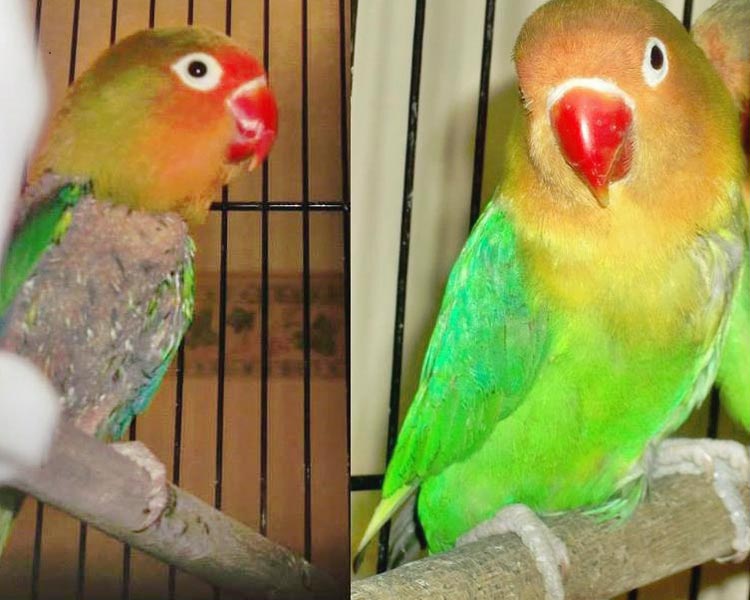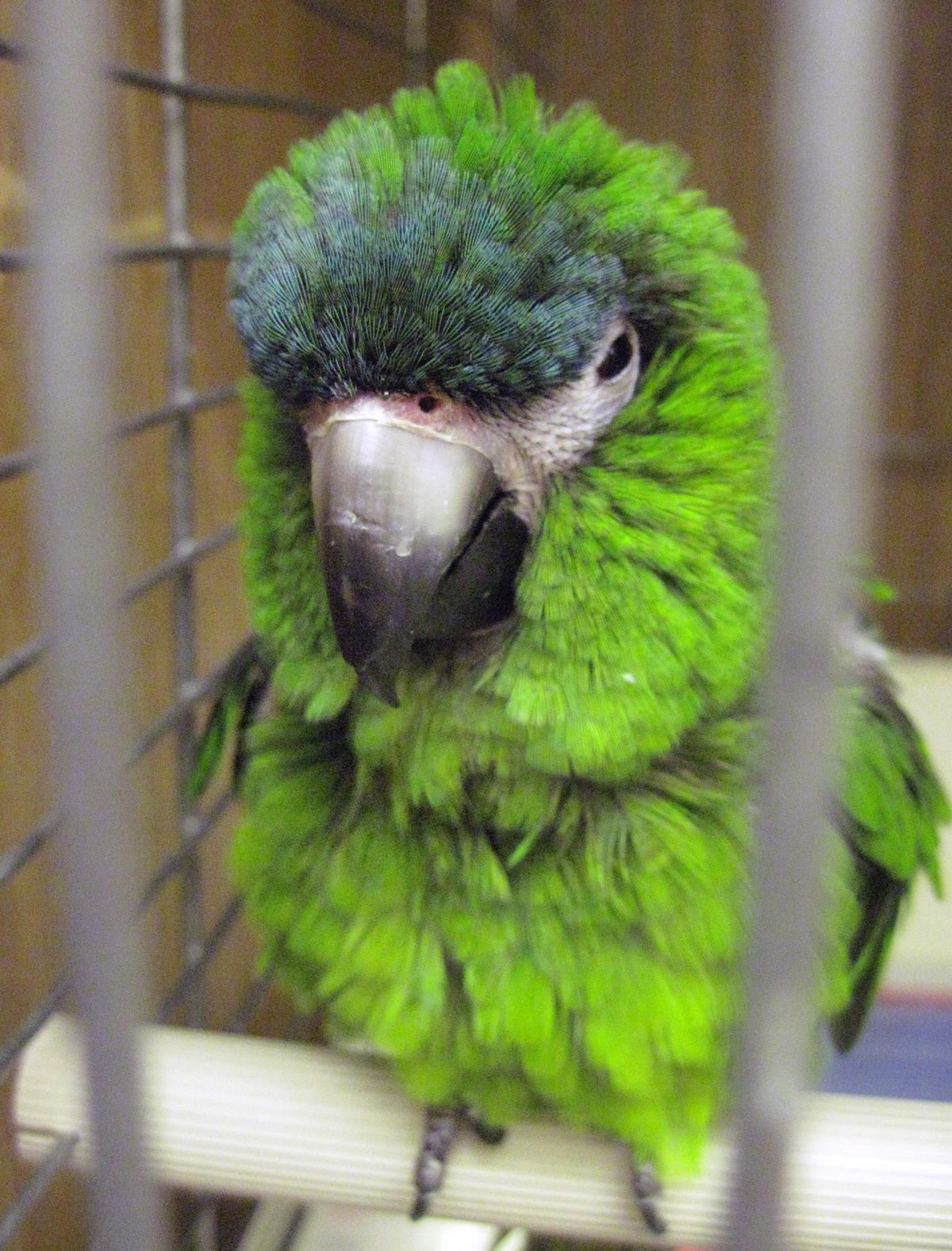7 Feb 2017
Care of psittacines: advice on basic principles part 2
RVN Clare Jones discusses the importance of providing parrots with environmental enrichment, and outlines common signs of illness.

Parrot fun.
Part one of this article discussed how to safely handle a parrot, taking into consideration its anatomical differences.
Cage cleanliness was also discussed due to the increased risk of inhaling bacterial and fungal spores – psittacines’ incredibly efficient respiratory systems mean these spores are able to spread rapidly around the body. Size of the cage is also incredibly important, allowing flight and full movement in a 360° direction – cramped cages can cause a parrot to become stressed and frustrated.
Finally, part one talked about diet and the importance of using a high-quality pellet or seed fit for human consumption, as well as the use of fresh fruit and vegetables. Poor-quality seed and an abundance of sunflowers is often seen and can result in a parrot with fungal diseases, as well as obesity or death.
Parrots are incredibly intelligent animals, but need regular enrichment and activities to work their brain and encourage interaction.
Neglected, bored and frustrated parrots can suffer, and signs of this will be clear to see.
Examples of items and situations harmful to parrots are listed in Panel 1, and this article explores some of these in more detail.
- Aerosols
- Smoke/burned foods
- Teflon pans
- Plug-ins
- Human food
- Sunflower seeds when not in moderation
- Paint
- Some disinfectants
- Toys containing lead or zinc
- Poor-quality parrot seed
- Unclean cages
- Hot food/drinks
- Cages too small
- Being without UV
- Not having chance to fly outdoors/chance to exhibit normal behaviour
- Wing clipping
- Being in a room with no social company
- Lack of regular enrichment
Environmental enrichment
Parrot-friendly toys (they will need to be checked to see if they contain poisonous lead paint) should be bought or made and, ideally, rotated each week if not already obliterated by the parrot during play. By rotating toys, the parrot is mentally stimulated on a regular basis, reducing boredom and stress.
Toys that can hide food, meanwhile, encourage foraging behaviour, as well as the enjoyment from shredding the toys in the process (Baker, 2012; Figure 1).

Interaction and exercise
Parrots are incredibly interactive and often bond to one member of the family. Regular interaction and play time with the chosen one is essential on a daily basis, as birds placed in a separate room away from humans for long periods of the day can become extremely depressed and stressed.
Exercise is a must. Parrots should be allowed out of their cages and to fly, as this is a natural exhibition of behaviour – being denied this can cause stress. Also, by being allowed to fly, a bird can maintain healthy muscle mass and reduce the chances of obesity.
Ideally, parrot owners should have an aviary giving access to fresh air and UV rays. If owners do not have this in place, a UV bird lamp should be provided, as UV is blocked by glass windows.
A lack of UV light can contribute to a number of problems. Firstly, UVB is incredibly important in the production of Vitamin D3, which is vital for calcium absorption and, therefore, essential for preventing metabolic bone disease and egg-laying difficulties.
UVA, meanwhile, is involved with an animal’s well-being in that it promotes the release of hormones and has been linked to increasing positive social patterns, as well as aiding daily preening and cleaning (Castro, 2012).
Common signs of illness
Owners may not necessarily recognise common signs of illness and, although VNs are not diagnosing a problem, knowing the signs can be very helpful. VNs look out for signs of potential illness in other companion animals on a regular basis – such as parasite infections, obesity and dental disease – and we should be aware of common signs shown in birds as they become an increasingly popular pet.
One important thing to note is, being a vulnerable prey species, birds will always mask any sign of illness (Froehlich and Forbes, 2015). If they didn’t, in the wild they would be at risk of injury or death by a predator species. Therefore, if a bird presents with any clinical signs, this indicates it is extremely unwell.
Feather plucking
A complex problem, feather plucking is not a normal behaviour (Figure 2). Owners may not always see a parrot physically removing feathers, but will find these at the base of the cage.

Feather plucking indicates a variety of problems. It can be a sign of stress and frustration – including sexual frustration – and dietary and/or behavioural problems. It may also indicate a physical or internal problem, as parrots sometimes pluck over the affected area.
Fluffed-up feathers
A bird may visibly look “fluffed”, as though its feathers have been ruffled – the parrot suddenly looks “puffed up” (Figure 3). More often than not, an emaciated body can be hidden among those feathers, and a full health and weight check should be performed.

Poor-quality feathers and weight gain/loss
Greasy, discoloured (often tinged black) feathers on an unkempt-looking bird can suggest a very poor-quality diet and/or illness. Coupled with weight gain and a history of poor-quality/fatty human food, this can suggest disorders such as hepatic lipidosis. Endoscopy and blood tests may aid to further diagnose this.
Behavioural changes
Owners may notice their bird has suddenly stopped talking, sleeps during the day or behaves in a different way. Dramatic changes in behaviour can be caused by illness or new stress factors in the bird’s life.
Respiratory changes
Heavy breathing, crackled breath sounds, tail bobbing and voice change are sure indicators of a problem. Birds are incredible animals made up of air sacs and pneumatic bones, so if any respiratory signs exist, the animal is in trouble.
Weight loss, anorexia and watery droppings
Weight loss, anorexia and watery droppings are all signs of potential problems that will require further diagnostics. Blood tests and faecal samples will need to be sent off, while, preferably, the bird is hospitalised for essential tube feeding.
Collapse, fitting and shaking
Collapse, fitting and shaking signs are often due to a nutritional disorder – for example, hypocalcaemia and/or a lack of Vitamin D3 (Gajanayake et al, 2011).
Wing clipping
VNs may come across clients who wish to have their parrot’s wings clipped. Reasons often include the owner not wanting the pet to fly, or “we let them in the garden and don’t want them to escape”.
An evolutionary reason exists for why birds have wings and preventing them doing something natural and innate can cause severe psychological problems (Stanford, 2002).
Birds become incredibly stressed if this procedure is allowed to happen. Not only do they show signs of anxiety, but, realistically, are often still able to fly. Therefore, the damage to the wings can instead cause them to crash or lose control during flight, causing other injuries.
A variety of bird harnesses are on the market allowing a bird to fly without the chance of escape, but a large aviary is the best option to allow outdoor flight.
Conclusion
Parrots are incredibly intelligent animals and seen regularly in practice. VNs should not be afraid about holding a parrot, but must take great care when it comes to bird anatomy.
VNs should also be aware of common signs and symptoms that indicate potential behavioural problems or illness, and should feel confident in guiding a client towards knowledge of basic cleanliness, mental stimulation and correct diet.
